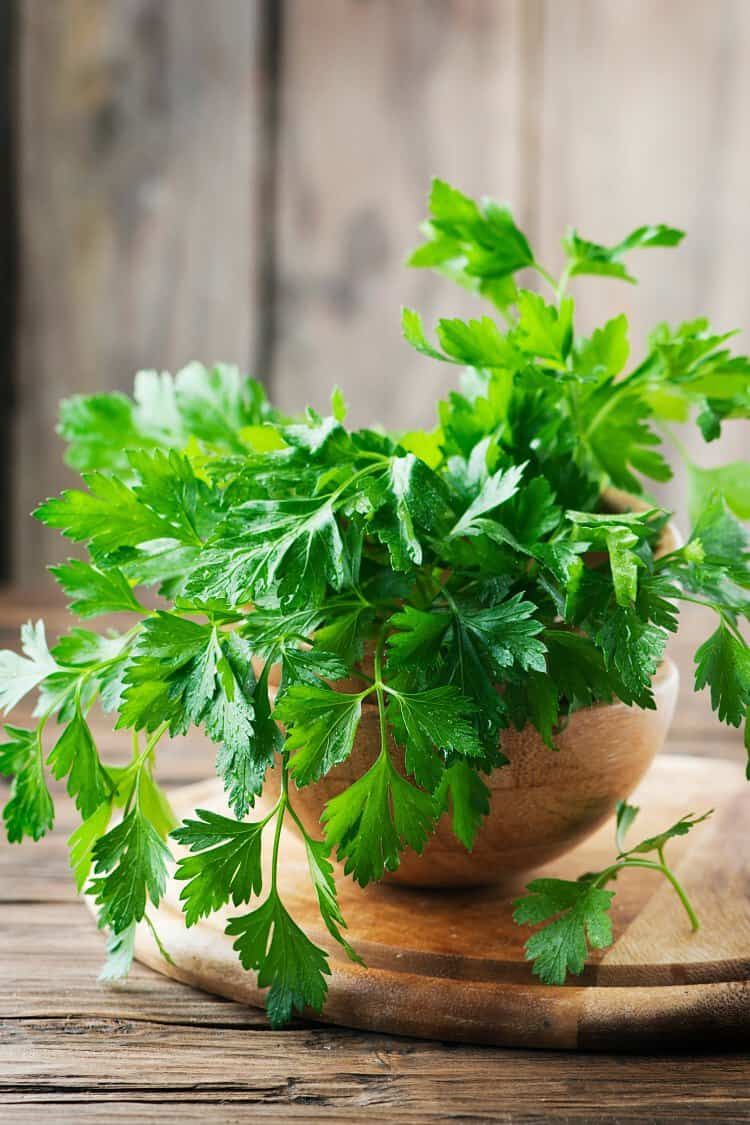Herbs and Spices - Parsley flakes

Parsley Flakes
PARSLEY LEAVES
Parsley or garden parsley (Petroselinum crispum) is a species of flowering plant in the family Apiaceae that is native to the central and eastern Mediterranean region (Lebanon, Israel, Cyprus, southern Italy, Greece, Portugal, Spain, Malta, Morocco, Algeria, and Tunisia), but has naturalized elsewhere in Europe, and is widely cultivated as a herb, and a vegetable.
Where it grows as a biennial, in the first year, it forms a rosette of tripinnate leaves, 10–25 cm (3.9–9.8 in) long, with numerous 1–3 cm (0.4–1.2 in) leaflets and a taproot used as a food store over the winter. In the second year, it grows a flowering stem with sparser leaves and umbels with yellow to yellowish-green flowers.
Parsley is widely used in European, Middle Eastern, and American cuisine. Curly leaf parsley is often used as a garnish. In central Europe, eastern Europe, and southern Europe, as well as in western Asia, many dishes are served with fresh green chopped parsley sprinkled on top. Flat leaf parsley is similar, but it is easier to cultivate, and some say it has a stronger flavor. Root parsley is very common in central, eastern, and southern European cuisines, where it is used as a snack or a vegetable in many soups, stews, and casseroles.
Benefits :
1. Contains many important nutrients: The herb is rich in many vitamins, particularly vitamin K, which is needed for blood clotting and bone health.Also a great source of vitamins A and C — important nutrients with antioxidant properties.
2. Rich in antioxidants: Parsley contains many powerful antioxidants that can benefit your health.Antioxidants are compounds that prevent cellular damage from molecules called free radicals. Your body requires a healthy balance of antioxidants and free radicals to maintain optimal health.
The main antioxidants in parsley are flavonoids,carotenoids,vitamin C
3. Supports bone health: Your bones need certain vitamins and minerals in varying amounts to remain healthy and strong.
Parsley is packed with vitamin K — an essential nutrient for bone health. Vitamin K helps build stronger bones by supporting bone-building cells called osteoblasts. This vitamin also activates certain proteins that increase bone mineral density — a measure of the amount of minerals present in your bones
4. Contains cancer-fighting substances: Parsley contains plant compounds that may have anticancer effects.
Oxidative stress — a condition characterized by an imbalance in levels of antioxidants and free radicals. Parsley is particularly rich in flavonoid antioxidants and vitamin C, which reduce oxidative stress in your body and may lower your risk of certain cancers.
5. Rich in nutrients that protect your eyes: Lutein, beta carotene, and zeaxanthin are three carotenoids in parsley that help protect your eyes and promote healthy vision. Carotenoids are pigments found in plants that have powerful antioxidant activity (26Trusted Source, 27Trusted Source). Lutein and zeaxanthin may prevent age-related macular degeneration (AMD), an incurable eye disease and a leading cause of blindness around the world.
6. May improve heart health: Parsley is a nutrient-dense herb that may improve heart health. For example, it’s a good source of the B vitamin folate — with 1/2 cup (30 grams) providing 11% of the RDI (3Trusted Source).
High intakes of dietary folate may reduce heart disease risk in certain populations.
7. Parsley extract has antibacterial properties:
Parsley may have antibacterial benefits when used as an extract.
The extract may also prevent the growth of bacteria in food. Another test-tube study found it prevented the growth of potentially harmful bacteria, such as Listeria and Salmonella — both known to cause food poisoning (39Trusted Source, 40Trusted Source, 41Trusted Source).
8. Easy to add to your diet:
Parsley is an extremely versatile and inexpensive flavoring option.
You can use the dried version as an ingredient in various recipes. It can enhance the flavor of soups, stews, and tomato sauces. Additionally, it’s often combined with other herbs in Italian-inspired recipes.
Fresh parsley is also a great addition to homemade salad dressings, marinades, and seafood recipes. Many people use fresh sprigs in recipes that don’t require cooking or add the herb at the end of the cooking period.
Serving ways:
• Use as a garnish on pasta or soups.
• Chop and add to salads.
• Use in egg bakes or frittatas.
• Make a pesto with pine nuts, olive oil, parmesan cheese, and fresh parsley.
• Add to smoothies for a nutrient and flavor boost.
• Use on homemade pizza.
• Add to homemade bread.
• Use in homemade juices.
• Add flavor to soups and stews.
• Incorporate into marinades and dressings.
• Use to flavor fish, poultry, and meat dishes